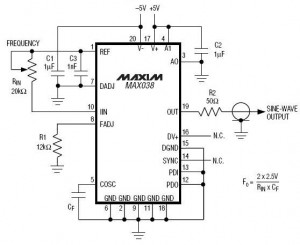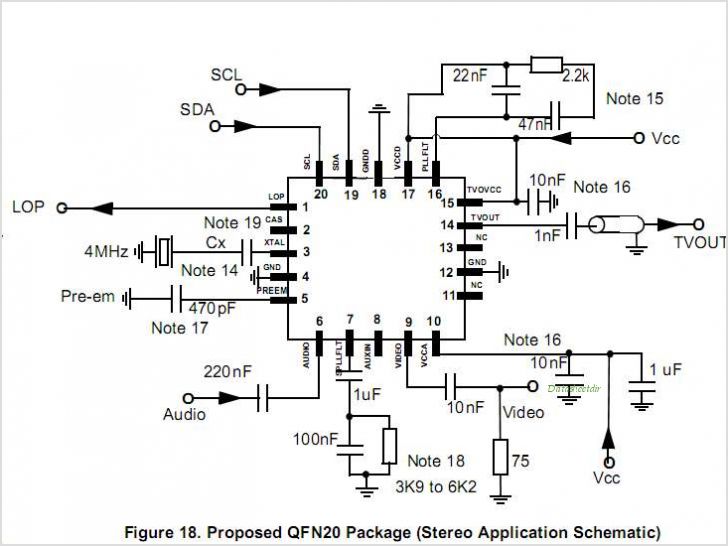
High Frequency Waveform GeneratorCircuit

A high-frequency waveform generator is highly beneficial for electronic experimentation and design. This circuit generates sine wave oscillations; however, it can be modified to produce triangle or square wave functions. The frequency can be controlled using current. By disconnecting the 20k resistor (RIN) from the reference pin (pin 1) and connecting it to a digital-to-analog converter (DAC), frequency control can be achieved through a microcontroller or digital interface. Additionally, the chip can be controlled using a quartz crystal (phase-locked loop, or PLL) by adjusting the current based on the output of a phase comparator that compares the sync output (pin 14 of the MAX038) with a reference clock from a quartz crystal oscillator. This waveform generator integrated circuit (IC) is notable for its ability to generate frequencies ranging from 0.1 Hz to 20 MHz, providing a wide operating frequency range, as expected from waveform generator instruments.
The high-frequency waveform generator circuit utilizes the MAX038 integrated circuit, which is designed for generating various waveform outputs with a significant frequency range. The circuit architecture typically includes a few key components: the MAX038 IC, resistors, capacitors, and a power supply. The IC features multiple output pins, allowing for sine, triangle, and square wave outputs, which can be selected and modified based on the circuit configuration.
To achieve frequency modulation, the circuit employs a resistor (RIN) connected to the reference pin (pin 1) of the MAX038. By replacing this resistor with a DAC, the frequency can be adjusted dynamically through digital control. This allows for precise frequency settings, which is particularly useful in applications requiring specific waveform characteristics. The DAC can be interfaced with a microcontroller, enabling easy programming and control over the waveform parameters.
Furthermore, the PLL functionality can be implemented by connecting a quartz crystal oscillator to the circuit. This setup enhances the frequency stability and accuracy of the waveform generated. The phase comparator within the circuit compares the output frequency from the MAX038 with the reference frequency from the quartz crystal, allowing for fine-tuning of the output waveform. This feedback mechanism ensures that the output frequency remains consistent, even with variations in supply voltage or temperature.
The MAX038's ability to generate frequencies from 0.1 Hz to 20 MHz makes it suitable for a wide range of applications, including signal testing, modulation experiments, and audio signal generation. The versatility of this waveform generator circuit makes it an essential tool in both educational and professional electronics environments, facilitating a deeper understanding of waveform generation and manipulation.High frequency waveform generator is very useful in electronic experiment and design. This circuit generate sine wave oscillation, but actually we can modify the circuit to generate triangle or square wave function. The frequency can be controlled using current. If we disconnect the 20k RIN from REF (pin 1) and connect it to a DAC, then we can con trol the frequency using microcontroller or digital interface. We can even control the chip using a quartz crystal (PLL) by controlling the current using a phase comparator output that compares the sync output (pin 14 of MAX038) and a reference clock from quartz crystal oscillator. This waveform generator integrated circuit chip is very interesting since it can generate 0. 1Hz to 20MHz, very wide operating frequency, as expected for every waveform generator instruments. 🔗 External reference
The high-frequency waveform generator circuit utilizes the MAX038 integrated circuit, which is designed for generating various waveform outputs with a significant frequency range. The circuit architecture typically includes a few key components: the MAX038 IC, resistors, capacitors, and a power supply. The IC features multiple output pins, allowing for sine, triangle, and square wave outputs, which can be selected and modified based on the circuit configuration.
To achieve frequency modulation, the circuit employs a resistor (RIN) connected to the reference pin (pin 1) of the MAX038. By replacing this resistor with a DAC, the frequency can be adjusted dynamically through digital control. This allows for precise frequency settings, which is particularly useful in applications requiring specific waveform characteristics. The DAC can be interfaced with a microcontroller, enabling easy programming and control over the waveform parameters.
Furthermore, the PLL functionality can be implemented by connecting a quartz crystal oscillator to the circuit. This setup enhances the frequency stability and accuracy of the waveform generated. The phase comparator within the circuit compares the output frequency from the MAX038 with the reference frequency from the quartz crystal, allowing for fine-tuning of the output waveform. This feedback mechanism ensures that the output frequency remains consistent, even with variations in supply voltage or temperature.
The MAX038's ability to generate frequencies from 0.1 Hz to 20 MHz makes it suitable for a wide range of applications, including signal testing, modulation experiments, and audio signal generation. The versatility of this waveform generator circuit makes it an essential tool in both educational and professional electronics environments, facilitating a deeper understanding of waveform generation and manipulation.High frequency waveform generator is very useful in electronic experiment and design. This circuit generate sine wave oscillation, but actually we can modify the circuit to generate triangle or square wave function. The frequency can be controlled using current. If we disconnect the 20k RIN from REF (pin 1) and connect it to a DAC, then we can con trol the frequency using microcontroller or digital interface. We can even control the chip using a quartz crystal (PLL) by controlling the current using a phase comparator output that compares the sync output (pin 14 of MAX038) and a reference clock from quartz crystal oscillator. This waveform generator integrated circuit chip is very interesting since it can generate 0. 1Hz to 20MHz, very wide operating frequency, as expected for every waveform generator instruments. 🔗 External reference





